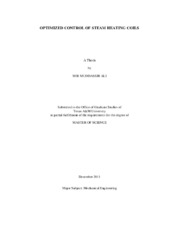| dc.description.abstract | Steam has been widely used as the source of heating in commercial buildings and industries throughout the twentieth century. Even though contemporary designers have moved to hot water as the primary choice for heating, a large number of facilities still use steam for heating. Medical campuses with on-site steam generation and extensive distribution systems often serve a number of buildings designed prior to the mid-1980s. The steam is typically used for preheat as its high thermal content helps in heating the air faster and prevents coils from freezing in locations with extreme weather conditions during winter.
The present work provides a comprehensive description of the various types of steam heating systems, steam coils, and valves to facilitate the engineer's understanding of these steam systems.
A large percentage of the steam coils used in buildings are provided with medium pressure steam. Veterans Integrated Service Network and Army Medical Command Medical Facilities are examples which use medium pressure steam for heating. The current design manual for these medical facilities recommends steam at 30psig be provided to these coils. In certain cases although the steam heating coil is designed for a 5psig steam pressure, it is observed that higher pressure steam is supplied at the coil. A higher steam pressure may lead to excessive heating, system inefficiency due to increased heat loss, simultaneous heating and cooling, and increased maintenance cost.
Field experiments were conducted to evaluate the effect of lowering steam pressure on the system performance. A 16% reduction in temperature rise across the coil was found when the steam pressure in the coil was reduced from 15psig to 5psig. The rise in temperature with lower pressure steam was sufficient to prevent coil freeze-up even in the most severe weather conditions. Additional benefits of reduced steam pressure are reduced flash steam losses (flash steam is vapor or secondary steam formed when hot condensate from the coil is discharged into a lower pressure area, i.e., the condensate return line) and radiation losses, increased flow of air through the coil thereby reducing air stratification and reduced energy losses in the event of actuator failure.
The work also involved evaluating the existing control strategies for the steam heating system. New control strategies were developed and tested to address the short comings of existing sequences. Improved temperature control and occupant comfort; elimination of valve hunting and reduced energy consumption were benefits realized by implementing these measures. | en |


